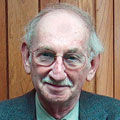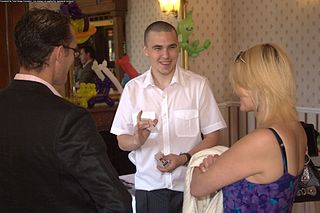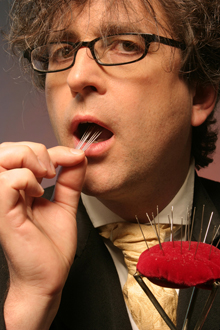Sleight of hand ) refers to fine motor skills when used by performing artists in different art forms to entertain or manipulate. It is closely associated with close-up magic, card magic, card flourishing and stealing. Because of its heavy use and practice by magicians, sleight of hand is often confused as a branch of magic; however, it is a separate genre of entertainment and many artists practice sleight of hand as an independent skill. Sleight of hand pioneers with worldwide acclaim include Dan and Dave, Ricky Jay, Derek DelGaudio, David Copperfield, Yann Frisch, Norbert Ferré, Dai Vernon, Cardini, Tony Slydini, Helder Guimarães and Tom Mullica.

Richard Jay Potash, was an American stage magician, actor and writer. In a 1993 profile for The New Yorker, Mark Singer called Jay "perhaps the most gifted sleight of hand artist alive". In addition to sleight of hand, he was known for his card tricks, card throwing, memory feats, and stage patter. He also wrote extensively on magic and its history. His acting credits included the films The Prestige, The Spanish Prisoner, Mystery Men, Heist, Boogie Nights, Tomorrow Never Dies, Heartbreakers, State and Main, House of Games and Magnolia, and the HBO series Deadwood. In 2015 he was the subject of an episode of PBS's American Masters, the only magician ever profiled in the series.

Card manipulation is the branch of magic that deals with creating effects using sleight of hand techniques involving playing cards. Card manipulation is often used in magical performances, especially in close-up, parlor, and street magic. Some of the most recognized names in this field include Dai Vernon, Tony Slydini, Ed Marlo, S.W. Erdnase, Richard Turner, John Scarne, Ricky Jay and René Lavand. Before becoming world-famous for his escapes, Houdini billed himself as "The King of Cards". Among the more well-known card tricks relying on card manipulation are Ambitious Card, and Three-card Monte, a common street hustle also known as Find the Lady.

Coin magic is the manipulating of coins to entertain audiences. Because coins are small, most coin tricks are considered close-up magic or table magic, as the audience must be close to the performer to see the effects. Though stage conjurers generally do not use coin effects, coin magic is sometimes performed onstage using large coins. In a different type of performance setting, a close-up coin magician will use a large video projector so the audience can see the magic on a big screen. Coin magic is generally considered harder to master than other close-up techniques such as card magic, as it requires great skill and grace to perform convincingly, and this requires much practice to acquire.
The Ambitious Card, or Elevator Card, is a magic effect in which a playing card seems to return to the top of the deck after being placed elsewhere in the middle of the deck. This is a classic effect in card magic and serves as a study subject for students of magic. Most performing card magicians will have developed their own personal Ambitious Card routine.

David Frederick Wingfield Verner, better known by his stage names Dai Vernon or The Professor, was a Canadian magician.
A double lift is a sleight of hand maneuver used by magicians in card magic. It is a method by which the identity of the top card may be kept secret by lifting the top two cards as one, making it seem as if only the top card is picked up. Similar techniques may be applied to more than two cards to perform a triple or even quadruple lift. The term was coined by Theo Annemann.
This timeline of magic is a history of the performing art of illusion from B.C. to the present.
Howard Schwarzman was an American magician, card manipulator, sleight of hand expert, and trick inventor. Considered a "living legend" in the Eastern United States magician community, he was best known as a columnist within the magician trade press, and an importer of very rare tricks from outside the United States.

Herbert Gershen Zarrow was an American magician influential in the profession for his inventions of unique sleight of hand and card tricks. The inventor of the Zarrow shuffle, his skills were held in the highest regard in professional magicians' circles.

The Expert at the Card Table, is an extensive book on the art of sleight of hand published in 1902 by S. W. Erdnase, a pseudonymous author whose identity has remained a mystery for over a century. As a detailed manual of card sharps, the book is considered to be one of the most influential works on magic or conjuring with cards.

Close-up magic is magic performed in an intimate setting usually no more than 3 meters from one's audience and is usually performed while sitting at a table.

The Tarbell Course in Magic is a notable encyclopedia of magic amongst professional and amateur magicians. It has eight volumes; the first five were part of the original home-study correspondence course compiled in 1928 by Harlan Tarbell, the remaining three volumes being added on later.

Lewis Jack Ganson was an English magician who became one of the most prolific writers in magic, going on to write and edit more than sixty books on the subject.

Magic, which encompasses the subgenres of illusion, stage magic, and close-up magic, among others, is a performing art in which audiences are entertained by tricks, effects, or illusions of seemingly impossible feats, using natural means. It is to be distinguished from paranormal magic which are effects claimed to be created through supernatural means. It is one of the oldest performing arts in the world.
Walter Irving Scott was an American musician, cardsharp and amateur magician. His glowing reputation among magicians and card men revolves around his time as a card cheat and a single demonstration of sleight-of-hand to some of the era's best magicians in New York in 1930. He lived out his last years in Rhode Island as a music teacher. Scott spent his formative years perfecting several difficult sleights of card manipulation in order to work as a cardsharp in card games throughout America. He participated in several different types of swindles and hustles. Eventually turning to a music career he was asked to perform one more demonstration. This single event created a legend within the magic community that continues to this day.

Gary 'Gazzo' Osbourne is a British street magician. Osbourne moved to the US in the 1980s, where he befriended Walter Irving Scott, also known as The Phantom. He is Scott's only pupil and the only person with whom Scott entrusted his biography and life's work at card cheating and sleights.

Richard J. Kaufman is an author, publisher, illustrator, and editor of books and magazines in the field of magic and amateur magicians of noted skill.

David Ben is a Canadian stage magician, sleight of hand artist, illusionist, author, publisher, keynote speaker, magic historian, magic consultant, magic collector and former tax lawyer.

Bruce Cervon was an American magician who was best known for his close-up magic, both through performance and invention. He published a series of books and helped to create a permanent record of the magic of Dai Vernon through The Vernon Chronicles, Dai Vernon's Ultimate Secrets of Card Magic, and Bruce Cervon's Castle Notebooks.














